Easter Egger Chickens: A COMPREHENSIVE Guide
I independently review every product I recommend. When you make a purchase through a link, I may earn a small commission at no additional cost to you. Learn more
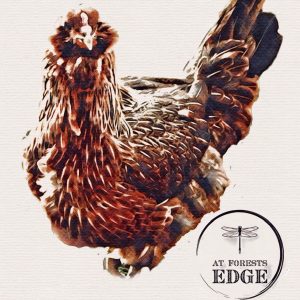
- 20 FACTS | Easter Egger Chickens
- What is an Easter Egger Chicken? Enigma of the Poultry Universe!
- History of the Easter Egger Chicken Breed
- Easter Egger Chicken Mythology
- Appearance of Easter Egger Chickens (He look-a like a chicken…)
- Easter Egger Chicken Size
- Easter Egger Chicken Eggs
- Eater Egger Chicken Temperament
- Easter Egger Chicken Health Check
- Easter Eggers Gotta Eat
- Coop & Run Size
- Easter Egger Chickens Pro’s & Con’s List
- Easter Egger Chickens F.A.Q.’s
20 FACTS | Easter Egger Chickens
| A.P.A. Class | All other standard breeds- miscellaneous |
| Origin | United States of America |
| Purpose | Dual Purpose (layer/meat bird) |
| Color | Varies |
| Weight | 4-5 lb |
| Life-Span | 5-8 years |
| Egg size | Medium- Large |
| Egg Color | Blues, Greens, Tans, Pale Pink |
| Egg Production | 200-280 eggs a year |
| Broodiness | Occasionally, not common |
| Disposition | Friendly |
| Forage/ Free Range | Excellent |
| Climate | Heat and Cold Tolerant |
| Beginner Friendly | Extremely |
| Maturation | 16-20 Weeks |
| Comb Type | Any |
| Muff | Sometimes |
| Beard | Yes |
| Skin Color | Yellow |
| Disease Susceptible | Mites, Lice, Scissorbeak |
What is an Easter Egger Chicken? Enigma of the Poultry Universe!
Whether you are a chicken aficionado or a novice, you may have come across the term Easter Egger Chicken. Easter Egger chickens are not a breed of chicken, rather a category of mixed breed chickens who received their colorful name because of the variation in colored eggs that come from any given flock. This mixed breed chicken can come with a variety of attributes because of the variation in parentage. But the blue egg laying gene seems to be the common ancestry this motley crew possesses.
History of the Easter Egger Chicken Breed
The parentage of any given Easter Egger is unclear, but it is widely accepted that one of the parents may be either an Araucana or an Ameraucana and a non-blue egg layer. Given the variety of non-blue egg laying chickens explains the difference in appearance.
Araucana Chickens
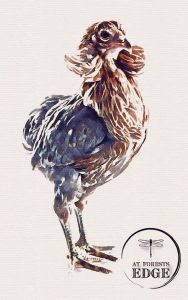
Originally Araucanas were brought to the United States of America from Chile, South America, in the 1930s. They are rumpless birds which means they are missing their entire coccyx. They won’t be shaking any talefeathers anytime soon. They were first bred from the Northern Chilean Collonca and Quetros chickens for the dominant blue gene for eggs and the rumpless tail. Araucana chickens also have distinct ear tufts that remind me of my husband’s golden locks that pop out on the side of his hat when he is in desperate need of a haircut.

The ear tuft gene can be lethal to the embryos. If both parent birds have the ear tuft gene, most of the chicks will die in the shell, hence their rarity.
Ameraucana Chickens
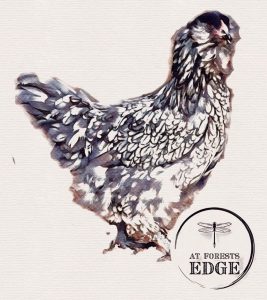
Ameraucana chickens are a fairly new breed developed in the 1970’s by breeding mixed breed chickens with the Araucanas. Once the desirable features were agreed upon a standard was issued and the Ameraucana was established. The goal was to retain the blue gene for eggs but eliminate the parents’ lethal gene, which caused ear tufts. The result was a bearded fluffy faced chicken that lays a beautiful blue egg. There are specific attributes that the A.P.A. requires for a chicken to be considered an Ameraucana. Those that don’t quite fit the standard are “Easter Eggers”.
Easter Egger Chicken Mythology

The Easter Egger and it’s predecessors have been speculated in some interesting myths. For history’s sake let’s do a brief overview in case you might come across such tale’s in the modern age.
Many, many moons ago hatcheries promoted the idea that the blue (Araucana) egg was lower in cholesterol than other egg types. Sorry to disappoint those egg lovers with cholesterol in mind. Chicken eggs contain the same cholesterol despite the color of the egg shell.
Oh and about the egg shell color. There are only 2 true egg colors in existence, blue & white. “What about those brown or green eggs?” I’ve seen them, you have probably seen them too, but sorry to say they are not truly brown or green. Brown eggs are white shells with a tinted coating that can be scratched off. And you guessed it, green eggs are really blue eggs with the same tinted coating. The tint may vary in depth and concentration. I love the wide array of colors available in a chicken egg. But truly there are only 2 colors. All you have to do is look inside to identify which one.
Appearance of Easter Egger Chickens (He look-a like a chicken…)
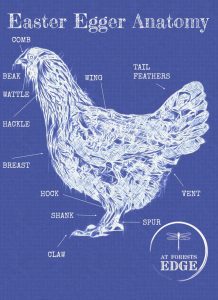
It can be frustrating trying to understand what a specific chicken looks like only to find out they vary, or they look like any chicken. Well that’s not entirely the case. Easter Eggers may vary in appearance due to their mixed heritage, however there are physical attributes that do come up over and over again that can be a good identifier that you may have an Easter Egger.
If they look like an Ameraucana but something’s not quite right, it might be an Easter Egger.
Sometimes they have muffs or beards like their Ameraucana parents. The chipmunk cheeks are a great attribute in an Easter Egger. They can be very hawk-like in appearance.
Sometimes they may have a pea comb like their blue egg laying parent otherwise they may have any one of the other comb types from the non-blue laying parent. Their skin is usually yellow unlike the Ameraucana parent. Which will give their legs a greenish appearance to yellow instead of the slate gray their Ameraucana parent would have. As for colors, you can find white, black, brown, or a mixture of completely random plumage. Which is the fun of having a flock of Easter Eggers. You never know what you are going to get!
Easter Egger Chicken Size
Generally Easter Eggers are a medium sized bird. They can be used as a dual purpose bird for either egg laying or meat. When it comes to meat, females average 4lbs. at maturity and males will average 5lbs. As with all aspects of their appearance, this could vary depending on genetics.
Easter Egger Chicken Eggs
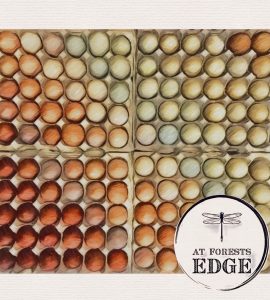
Egg Color of Easter Egger Chicken Eggs
Easter Eggers can lay blues, blue-greens, greens, olive-greens, tans, and sometimes pink!
You may have heard of their reputation for laying different colored eggs. Did you know that one bird will not lay a variety of colors in its lifetime? The color of the egg will stay the same during its lifetime. So an Easter Egger that lays a blue egg will not suddenly start laying green eggs. In any given flock each bird may lay an egg that is unique in itself. In order to get a variety of colored eggs, you need multiple birds.
Egg Size and Frequency of Easter Egger Chickens
Easter Eggers lay a medium to large egg. Averaging on the medium size. Once they reach maturity they can lay anywhere from 200-280 eggs a year. That is a big gap so you will have to take some trial and error to get your chicken math correct. The limited light may slow the egg production in the winter. But Easter Eggers are known for pushing through and continuing to lay even in the winter. It may be less eggs, but it is better than a grinding halt.
If you would like to learn more about chickens eggs, check out my article on how they go from farm to table.
Eater Egger Chicken Temperament
Easter Eggers are a lovely bird with a sunny disposition. This friendly bird is perfect for a backyard flock, or if you have a large family. Of course personality can vary depending on breeding and handling. If you want a friendly flock, handle the chicks at a young age and socialize them throughout all the stages of life. If proper care and attention is given at a young age then you will have a loyal and gentle companion. Hand-feeding is a great way to earn your chicken’s trust. Just like my husband, the fastest way to our chicks heart is their stomach.
When it comes to other birds they are not bully’s. Often the more dominant birds may take over so watch out for these gentle souls.
Easter Eggers have an excellent temperament for the beginner chicken keeper.
(Don’t worry, it won’t be long until you join the crazy chicken people club).
Easter Egger Chicken Health Check
Easter Eggers are generally healthy chickens. Probably because of their mixed heritage, they are not prone to diseases that many pure breeds may fall to like bumblefoot and water on the brain. It’s similar to how purebred dogs have trending health issues but mutts get a better health check due to their diverse background.
Mites and Lice
If you lie down with dogs you will wake up with fleas. Well chickens have their own pest issues. Mites and lice are a common chicken pest that can be prevented if you take the right measures. A dust bath is a great preventative measure to deter and dry out mites, lice and even fleas from your flock. Chicken lice is not transmitted to humans. You may feel extra itchy just thinking about it. Go ahead scratch that itch. Don’t worry, chicken lice are not the same as lice going around at the elementary school. No need to get rid of the chickens if the kids need some special shampoo.
Scissor Beak

Easter Eggers while super healthy are not impervious to health issues. The infamous Scissor beak, Cross beak, or crooked beak has been detected in some Easter Egger chickens. It is a condition when the top and bottom beaks do not align properly. This can be due to inferior genetics, an injury to the chick’s skull causing the grow plates to not grow at the same rate or incorrect incubation temperature, which is less common among chicks incubated by a mother hen. Sometimes the beaks grow too long because the chickens have not had time scratching at rocks.
Don’t fret, if you have a chick with a scissor beak, it’s not a death sentence. They can still live a pretty good life. A deeper feeder or waterer can help them when scooping food into their lower beak. Sometimes filing the beak can help. Every situation is unique, but there is hope. Consult your chicken vet to make the best decisions for your flock.
Easter Eggers Gotta Eat
Chick Starter Feed
You may be wondering what to feed these beautiful birds. Do they have a chicken version of the fancy stuff that leaves you with an annoying earworm running through your mind? Cluck, cluck, cluck, cluck…
No, crazy music. There are brands of chicken feed out there, some more popular. Some with organic in the title. Some say medicated and others are unmedicated. A local feed store may have a big ol’ bag of chicken feed. Whatever you decide is up to you.
Chicken aficionados tend to agree to start baby chicks with a starter feed until they reach maturity (lay their first egg). Chick starter feed that includes at least 18% protein can provide the extra energy needed for early growth. It’s also recommended to include amino acids for chick development; prebiotics, probiotics and yeast for immune health; and vitamins and minerals to support bone health.
Some starter feeds also contain grit which helps them digest all this good nutrition. If not you can purchase grit too. As chickens get bigger and go outside they could possibly find pebbles themselves while foraging if you plan on going that route.
Chicken Feed
As with chick feed, there are many options. Be a good chicken parent and research what’s best for you and your flock. There are layer feeds with 16% protein that can provide all essential nutrition. Layer chickens need calcium for healthy eggs with strong shells.
Crushed oyster shells are a good calcium supplement to feed your laying chickens.
Crushing up extra chicken egg shells is another cost effective route.
If you are a gardener you will love the flexibility of feeding your flock. They love treats from the garden. People have been converting scraps to compost and keeping a healthy garden cycle for ages.
There are also tricks to ferment or sprout your feed to make it last longer.
And of course, don’t forget bugs! Bugs,bugs everywhere, ready for chickens to eat.
You don’t realize how many bugs are all around you until you start a garden, even more so AT FORESTS EDGE. We have encountered more insects than ever in our lives since moving here. I’m not talking about potato bug encounters while playing in the mud. I mean walking outside and a freaky looking thing lands on you and when you are finished doing the “What is it? Get it off me dance.” you take a picture to identify the miniature monster to see if it wants to eat you! As you can tell, I love the chicken’s appetite for all things creepy crawly. Eat them, eat them all!
Coop & Run Size
On this episode of Coops, 2Flock is going to show us around his Chicken Mansion…
Chickens do not need a mansion, but they do need plenty of space to be happy and healthy.
Chickens require 2-4 feet per bird in a hen house and 8-10 feet per bird in a run. We recommend erring on the bigger side because, chicken math. You will figure that out as time goes on being a chicken parent. More space is better if you have a lot of chickens because it will give them space to separate and usually keeps them from getting irritated with each other. It’s kind of like what happens when you cram kids in the back of the car for a long trip. They may all fit back there, but a few miles in and you will wish you had more seating.
Chickens need a roosting bar that is 8-10 inches per chicken. We plan on giving our chickens at least 1 foot per bird on their roosting bars. Chickens are flat footed so they do prefer a flat roosting bar, however they do like to curl their toes around the front so make sure whatever roost bar you decide is accommodating.
Also make sure to have plenty of ventilation in your coop. Remember a well ventilated coop is a healthy coop.
This article has everything you need for a Perfect Chicken Coop for You!
Easter Egger Chickens Pro’s & Con’s List
| Pro’s | Con’s |
| Friendly & great with kids! | Lower in the pecking order, may get bullied. |
| Great egg layers with beautifully colored eggs! | No guarantee what color egg a chicken will lay. |
| Optimum health compared to most chickens due to mixed parentage! | Might have scissor-beak. |
| Excellent Foragers | Curiosity may put them in danger. |
| Diverse appearance, great for identifying personality and naming each bird. | Mixed parentage, not a recognized breed of chicken. Not showing these birds at the fair. |
Easter Egger Chickens F.A.Q.’s
| Questions: | Answers: |
| What color eggs do Easter Eggers lay? | Easter Eggers can lay eggs that range from blues, blue-greens, greens, olive-greens, tans, and sometimes pink! |
| How many eggs will an Easter Egger lay in a year? | Easter Egger hens lay between 200-280 eggs per year. Roo’s lay 0, because they are roosters (that means male chicken). |
| Are Easter Egger Chickens aggressive? | Easter Eggers are not aggressive chickens. They are friendly, docile chickens. The more socialization a chicken receives will cause it to be less skittish and more friendly. |
| Do Easter Egger Hens go broody? | Easter Egger hens rarely go broody. However there have been instances where some have gone broody. It depends on the chicken. |
| Are Easter Eggers susceptible to certain diseases? | Easter Eggers are not typically susceptible to many diseases, but a genetic condition known as scissor beak has a higher rate in Easter Eggers than other chickens. |
| Can Lice spread from chicken to humans? | No, chicken lice is not the same lice that humans contract. |
| Can I show my Easter Egger Chicken at the Fair? | No, Easter Eggers are not recognized as a standard breed and not accepted to show. |
I hope this information was helpful to you. Let me know if you would like more information on starting chickens for the first time. I am so pleased with our Easter Egger hens. Best decision ever!
For more resources picking your favorite chickens check out:
15 Kid-Friendly Chicken Breeds and Which to Avoid
Raising a Rooster: Should You Add a Cockerel to Your Flock?
Baby Chick Care: Complete Guide for Happy, Healthy Birds
If you would like to be companions in this journey join my email list where I share encouragement throughout the seasons to grow HOPE in your homestead and in your life! (Sometimes that includes crazy things like raising chickens!)
Until we meet again,
Raeanna





